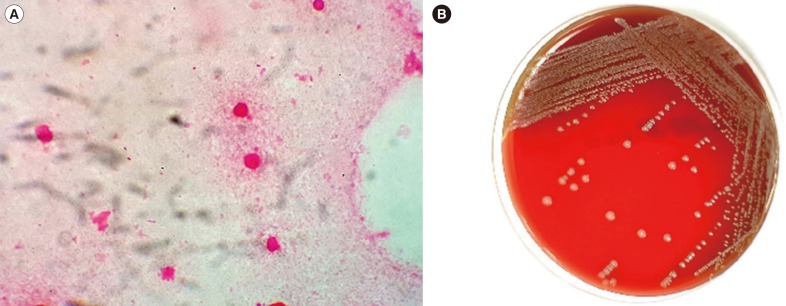Ann Lab Med.
2016 Nov;36(6):617-619. 10.3343/alm.2016.36.6.617.
Identification of Pasteurella canis in a Soft Tissue Infection Caused by a Dog Bite: The First Report in Korea
- Affiliations
-
- 1Department of Internal Medicine, Hanyang University of College of Medicine, Seoul, Korea.
- 2Department of Orthopediatrics, Hanyang University of College of Medicine, Seoul, Korea.
- 3Department of Laboratory Medicine, Hanyang University of College of Medicine, Seoul, Korea. yangsoon@hanyang.ac.kr
- KMID: 2373605
- DOI: http://doi.org/10.3343/alm.2016.36.6.617
Abstract
- No abstract available.
MeSH Terms
-
Animals
Anti-Bacterial Agents/pharmacology
Bites and Stings
Disk Diffusion Antimicrobial Tests
Dogs
Female
Humans
Middle Aged
Pasteurella/drug effects/genetics/*isolation & purification
Pasteurella Infections/*diagnosis/microbiology
RNA, Ribosomal, 16S/chemistry/genetics/metabolism
Republic of Korea
Sequence Analysis, DNA
Soft Tissue Infections/*diagnosis/microbiology
Anti-Bacterial Agents
RNA, Ribosomal, 16S
Figure
Cited by 1 articles
-
Virulence-associated Genome Sequences of
Pasteurella canis and Unique Toxin Gene Prevalence ofP. canis andPasteurella multocida Isolated from Humans and Companion Animals
Haruno Yoshida, Jung-Min Kim, Takahiro Maeda, Mieko Goto, Yuzo Tsuyuki, Sachiko Shibata, Kenichi Shizuno, Katsuko Okuzumi, Jae-Seok Kim, Takashi Takahashi
Ann Lab Med. 2023;43(3):263-272. doi: 10.3343/alm.2023.43.3.263.
Reference
-
1. Talan DA, Citron DM, Abrahamian FM, Moran GJ, Goldstein EJ. Bacteriologic analysis of infected dog and cat bites. Emergency Medicine Animal Bite Infection Study Group. N Engl J Med. 1999; 340:85–92. PMID: 9887159.2. Albert TJ. The first case of Pasteurella canis bacteremia: a cirrhotic patient with an open leg wound. Infection. 2010; 38:483–485. PMID: 20623245.3. Castellano I, Marín JP, Gallego S, Mora M, Rangel G, Suarez MA, et al. Pasteurella canis peritonitis in a peritoneal dialysis patient. Perit Dial Int. 2011; 31:503–504. PMID: 21799062.4. Hara H, Ochiai T, Morishima T, Arashima Y, Kumasaka K, Kawano KY. Pasteurella canis osteomyelitis and cutaneous abscess after a domestic dog bite. J Am Acad Dermatol. 2002; 46:S151–S152. PMID: 12004298.5. Hazelton BJ, Axt MW, Jones CA. Pasteurella canis osteoarticular infections in childhood: review of bone and joint infections due to pasteurella species over 10 years at a tertiary pediatric hospital and in the literature. J Pediatr Orthop. 2013; 33:e34–e38. PMID: 23482278.6. Clinical and Laboratory Standards Institute. Methods for antimicrobial dilution and disk susceptibility testing of infrequently isolated or fastidious bacteria. Approved guideline, M45-A2. 2nd ed. Wayne, PA: Clinical and Laboratory Standards Institute;2010.7. Abrahamian FM, Goldstein EJ. Microbiology of animal bite wound infections. Clin Microbiol Rev. 2011; 24:231–246. PMID: 21482724.8. Lion C, Conroy MC, Carpentier AM, Lozniewski A. Antimicrobial susceptibilities of Pasteurella strains isolated from humans. Int J Antimicrob Agents. 2006; 27:290–293. PMID: 16564680.9. Stevens DL, Bisno AL, Chambers HF, Dellinger EP, Goldstein EJ, Gorbach SL, et al. Practice guidelines for the diagnosis and management of skin and soft tissue infections: 2014 update by the Infectious Diseases Society of America. Clin Infect Dis. 2014; 59:147–159. PMID: 24947530.10. Citron DM, Warren YA, Fernandez HT, Goldstein MA, Tyrrell KL, Goldstein EJ. Broth microdilution and disk diffusion tests for susceptibility testing of Pasteurella species isolated from human clinical specimens. J Clin Microbiol. 2005; 43:2485–2488. PMID: 15872290.
- Full Text Links
- Actions
-
Cited
- CITED
-
- Close
- Share
- Similar articles
-
- Isolation of Pasteurella dagmatis from Dog-bite Wounds
- A Case of Bergeyella zoohelcum Isolated from a Patient with Cellulitis after a Dog Bite
- Virulence-associated Genome Sequences of Pasteurella canis and Unique Toxin Gene Prevalence of P. canis and Pasteurella multocida Isolated from Humans and Companion Animals
- First Case of Canine Infection with Hepatozoon canis (Apicomplexa: Haemogregarinidae) in the Republic of Korea
- Clinical Practice Guidelines for Soft Tissue Infections


